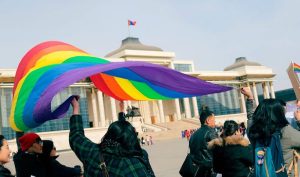131 Global News Post 3
mykel2
On August 12, 2020, international news outlet Global Voices published Amedeo Bastiano’s article “For LGBTQ+ People in Mongolia, Stigma is a Fact of Life.” In this article, freelance journalist Bastiano interviews an anonymous bisexual 19-year old woman from Mongolia; she is referred to by the pseudonym Erdene.
In the interview, Erdene describes the prevalence of anti-queer discrimination in Mongolia. She states that while homophobic discrimination is outlawed, it is neglected by most law enforcement. She states that most Mongolians are unfamiliar with sexuality-related terminology, so if she “had to tell the average Mongolian that [she is] bisexual, they . . . wouldn’t react either positively or negatively . . . because they wouldn’t understand.” However, “if [she] showed it with [her] actions – that would make them surprised.” Erdene states that if she was seen kissing a girl in public, she would probably be stopped, and if she were a male or masculine, the consequences might be far worse. She describes the moment that caused her to come out: her friend’s masculine girlfriend was at a queer event hosted at a venue, and when she exited, she was beaten by three men who had been informed by the bouncer that queer people were convening inside. Erdene shared her perspective on the event, saying, “that made me understand what discrimination can lead to. And that awareness is why I’m open about my orientation. I am open, because nobody [else] is. Because if nobody speaks out about the situation, nobody will know.”

Erdene discusses domestic initiatives to mitigate anti-LGBTQ+ discrimination, highlighting a local LGBTQ+ center that hosts pride events. She says that the organization is small, with just four workers, all of whom are volunteers, and states that at the last pride walk she attended, there were less than 50 participants. However, she clarifies that this does not mean that there are not many queer people in Mongolia: she states that while official numbers indicate that Mongolia has between 300-500 queer individuals, surveys indicate that there are at least 30,000 queer people across Mongolia, and the true number is likely much higher, being underreported due to stigma and the accompanying fear felt by queer individuals.
The contents of Bastiano’s article are largely anecdotal, with only one reference cited within the text. However, its interview format allows readers to empathize with a queer perspective in Ulaanbaatar and understand Mongolia through a lens often overshadowed. When Erdene discusses the LGBTQ+ center in Ulaanbaatar, she states that “there is no media coverage; almost nobody knows that such events take place. And when people don’t speak about our activities, the impact of what we do fades away quickly.” Thus, the importance of reporting on digitally underrepresented perspectives is underscored: such endeavors may slow the fading of marginalized experiences and their impacts and hasten the speed of progress in the quality of life of individuals like Erdene.
Image Reference: Bastiano, A. (2020, August 21). For LGBTQ+ People in Mongolia, Stigma is a Fact of Life. Global Voices. Retrieved from https://globalvoices.org/2020/08/21/for-lgbtq-people-in-mongolia-stigma-is-a-fact-of-life/